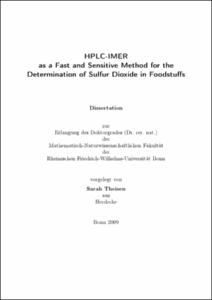Theisen, Sarah: HPLC-IMER as a Fast and Sensitive Method for the Determination of Sulfur Dioxide in Foodstuffs. - Bonn, 2009. - Dissertation, Rheinische Friedrich-Wilhelms-Universität Bonn.
Online-Ausgabe in bonndoc: https://nbn-resolving.org/urn:nbn:de:hbz:5N-19081
Online-Ausgabe in bonndoc: https://nbn-resolving.org/urn:nbn:de:hbz:5N-19081
@phdthesis{handle:20.500.11811/4142,
urn: https://nbn-resolving.org/urn:nbn:de:hbz:5N-19081,
author = {{Sarah Theisen}},
title = {HPLC-IMER as a Fast and Sensitive Method for the Determination of Sulfur Dioxide in Foodstuffs},
school = {Rheinische Friedrich-Wilhelms-Universität Bonn},
year = 2009,
month = oct,
note = {HPLC-IMER (HPLC with an immobilized enzyme reactor) is a combination of an isocratic HPLC system with an integrated immobilized enzyme reactor and electrochemical detection for the analysis of sulfites. The aim of this work was to optimize the HPLC-IMER method for different food matrices, to compare different sulfite oxidases, and to compare the HPLC-IMER with the official method for sulfite analysis.
Several HPLC-IMER parameters were optimized, with a focus on an effective sample preparation for different foodstuffs. With a programmable autosampler, the effects of different parameters (reaction times of water, carbonate buffer, and sodium hydroxide) on the release of bound sulfites were studied. It was found that treatment with sodium hydroxide is essential in the release of bound sulfites, with longer reaction times required for samples rich in anthocyanins.
For the first time, an enzyme reactor with plant sulfite oxidase from Arabidopsis thaliana was employed in biosensor analysis, and its performance was compared with the animal sulfite oxidase from chicken liver (EC 1.8.3.1). The novel plant sulfite oxidase has a much broader linear range (0.04 up to more than 20 mg/L) than the animal enzyme (0.04 - 0.8 mg/L). Furthermore, the immobilized enzyme from Arabidopsis thaliana was shown to be a lot more stable in the course of many analyses. Thus, regarding the application in HPLC-IMER, the plant sulfite oxidase is superior to the animal sulfite oxidase.
The general applicability of the HPLC-IMER for a number of different foodstuffs was shown. Many samples like fruit juices, fruit nectars, sugar sirups, jelly, wine and smoothies were successfully analyzed. In a storage study over seven months, the alteration of sulfite contents in a commercial red grape juice was examined with the HPLC-IMER.
The optimized HPLC-IMER method was compared to the official distillatory method of sulfite analysis (IFU 7a) and the newly developed DE-HPLC-IMER in the diploma thesis of Kothe. In almost all cases, the HPLC-IMER leads by far to the highest sulfite findings. The results for sulfite contents are up to 100% above those of the IFU 7a and the DE-HPLC-IMER. Additionally, the HPLC-IMER method generally shows a significantly lower detection limit, as well as a lower standard deviation.
After all, this method has many advantages compared to the official methods, as it is not only more sensitive and precise, but also simple to perform, automatable and fast.},
url = {https://hdl.handle.net/20.500.11811/4142}
}
urn: https://nbn-resolving.org/urn:nbn:de:hbz:5N-19081,
author = {{Sarah Theisen}},
title = {HPLC-IMER as a Fast and Sensitive Method for the Determination of Sulfur Dioxide in Foodstuffs},
school = {Rheinische Friedrich-Wilhelms-Universität Bonn},
year = 2009,
month = oct,
note = {HPLC-IMER (HPLC with an immobilized enzyme reactor) is a combination of an isocratic HPLC system with an integrated immobilized enzyme reactor and electrochemical detection for the analysis of sulfites. The aim of this work was to optimize the HPLC-IMER method for different food matrices, to compare different sulfite oxidases, and to compare the HPLC-IMER with the official method for sulfite analysis.
Several HPLC-IMER parameters were optimized, with a focus on an effective sample preparation for different foodstuffs. With a programmable autosampler, the effects of different parameters (reaction times of water, carbonate buffer, and sodium hydroxide) on the release of bound sulfites were studied. It was found that treatment with sodium hydroxide is essential in the release of bound sulfites, with longer reaction times required for samples rich in anthocyanins.
For the first time, an enzyme reactor with plant sulfite oxidase from Arabidopsis thaliana was employed in biosensor analysis, and its performance was compared with the animal sulfite oxidase from chicken liver (EC 1.8.3.1). The novel plant sulfite oxidase has a much broader linear range (0.04 up to more than 20 mg/L) than the animal enzyme (0.04 - 0.8 mg/L). Furthermore, the immobilized enzyme from Arabidopsis thaliana was shown to be a lot more stable in the course of many analyses. Thus, regarding the application in HPLC-IMER, the plant sulfite oxidase is superior to the animal sulfite oxidase.
The general applicability of the HPLC-IMER for a number of different foodstuffs was shown. Many samples like fruit juices, fruit nectars, sugar sirups, jelly, wine and smoothies were successfully analyzed. In a storage study over seven months, the alteration of sulfite contents in a commercial red grape juice was examined with the HPLC-IMER.
The optimized HPLC-IMER method was compared to the official distillatory method of sulfite analysis (IFU 7a) and the newly developed DE-HPLC-IMER in the diploma thesis of Kothe. In almost all cases, the HPLC-IMER leads by far to the highest sulfite findings. The results for sulfite contents are up to 100% above those of the IFU 7a and the DE-HPLC-IMER. Additionally, the HPLC-IMER method generally shows a significantly lower detection limit, as well as a lower standard deviation.
After all, this method has many advantages compared to the official methods, as it is not only more sensitive and precise, but also simple to perform, automatable and fast.},
url = {https://hdl.handle.net/20.500.11811/4142}
}






